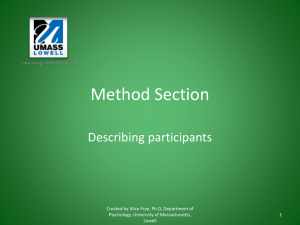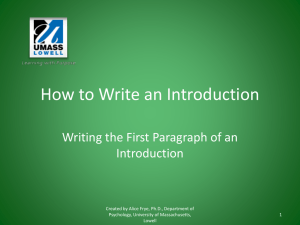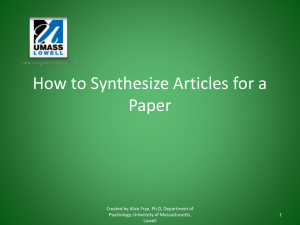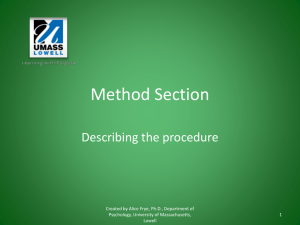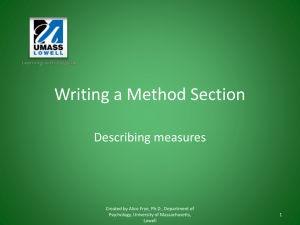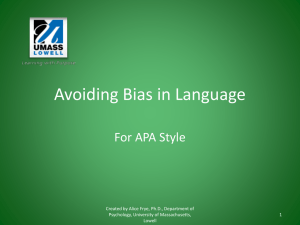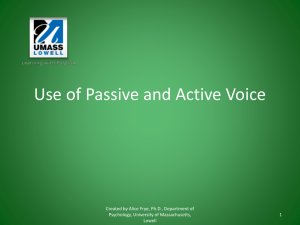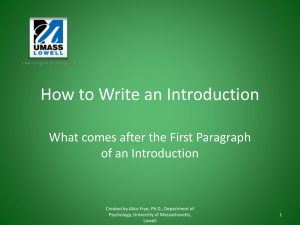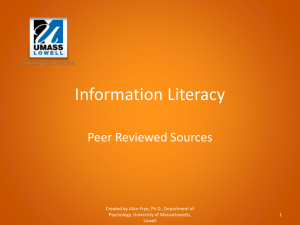How to Paraphrase - University of Massachusetts Lowell
advertisement
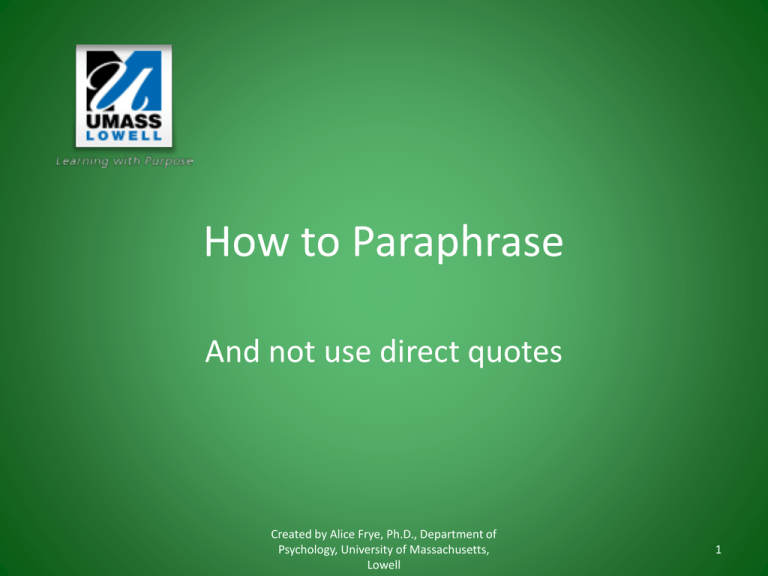
How to Paraphrase And not use direct quotes Created by Alice Frye, Ph.D., Department of Psychology, University of Massachusetts, Lowell 1 Steps in this tutorial • • • • • • 1) State the goal of this tutorial 2) What is paraphrasing 3) Quoting and paraphrasing in writing 4) Why psychologists paraphrase 5) Example of turning quote into a paraphrase 6) Example of paraphrasing information from multiple articles at one time Created by Alice Frye, Ph.D., Department of Psychology, University of Massachusetts, Lowell 2 Goal • To explain what paraphrasing is • To explain why psychologists do it • To demonstrate how to do it Created by Alice Frye, Ph.D., Department of Psychology, University of Massachusetts, Lowell 3 Objectives • By the end of this tutorial you should be able to – Know what paraphrasing is – Know the difference between paraphrasing and quoting – Turn information from one or more articles into a paraphrased statement in your own work Created by Alice Frye, Ph.D., Department of Psychology, University of Massachusetts, Lowell 4 What is Paraphrasing • Paraphrasing is what it sounds like if you break it into two parts – Para—sort of – Phrasing—saying • Paraphrasing is restating something written by someone else in your own words • In psychology writing we often use this instead of quoting • When you paraphrase you must still cite the original author Created by Alice Frye, Ph.D., Department of Psychology, University of Massachusetts, Lowell 5 Quoting and Paraphrasing are Used in Different Types of Writing • Other types of writing, such as writing about literature or some types of argumentative writing, often use quotes • That is, they take pieces of writing directly from another work and quote them and then cite the original author • You may have been trained to do this in other classes • Why don’t psychologists just do this? Created by Alice Frye, Ph.D., Department of Psychology, University of Massachusetts, Lowell 6 Why do Psychologists Paraphrase? • In psychology writing, we are often trying to summarize several ideas from a single article, or summarize ideas from several articles • Using quotes from each and every article can make it hard to present a clear argument • It also leads to unnecessarily long descriptions • Paraphrasing is shorter and easier to read • But it must always include citations for the original source Created by Alice Frye, Ph.D., Department of Psychology, University of Massachusetts, Lowell 7 Quoting from one article-Example • This example shows an example of an extensive quote. The next page shows how this section can be simply paraphrased Block and colleagues described the problems with jurors assessment of reports “Juror decisions are based on this memory representation, rather than on the original raw evidence…the facts in essence become less relevant than what the jurors remember in their reconstruction of the facts” (Block, Greenberg & Goodman, 2009, p 2860). Created by Alice Frye, Ph.D., Department of Psychology, University of Massachusetts, Lowell 8 Paraphrasing one article-Example • This example shows a paraphrase of the previous page Block and colleagues described that jurors own memories influence their decisions (Block, Greenberg & Goodman, 2009). • You the writer must be able to understand and say what about the quote is important to your own paper—this is what makes it possible for you to paraphrase • The paraphrase is shorter, but still presents the idea of importance • Without quotations no page number is needed Created by Alice Frye, Ph.D., Department of Psychology, University of Massachusetts, Lowell 9 Paraphrasing more than One ArticleExample • Suppose you have read two articles on a similar topic and you want to include information from both • One way would be to include quotes from both articles • The next slide demonstrates this Created by Alice Frye, Ph.D., Department of Psychology, University of Massachusetts, Lowell 10 Paraphrasing more than One ArticleExample • Suppose your topic is community changes related to intergroup relationships, here is the first quote Dinh and Bond (2008, p 283-284) note important questions in intergroup relationships between immigrants and host cultures “How do we incorporate consideration of developmental, situational, contextual, political, and historical factors? …What roles do differential privilege and power play in limiting mutual accommodation of dominant and non-dominant cultural groups?” Created by Alice Frye, Ph.D., Department of Psychology, University of Massachusetts, Lowell 11 Paraphrasing more than One ArticleExample • You also want to tie this to ideas about how different groups find common ground and share power on community boards, here is the second quote Bond and Keyes (1993, p. 39) suggest that distinct stakeholders can work together to create what they refer to as coempowerment “We believe this coempowerment of multiple constituencies is not merely a unique occurrence in the particular community agency studied. Rather, from our analysis, coempowerment appears to result from creating an organizational culture that supports (a) the groups' capacity for meaningful inclusion and (b) each group's access to resources.” Created by Alice Frye, Ph.D., Department of Psychology, University of Massachusetts, Lowell 12 Paraphrasing more than One ArticleExample • By paraphrasing instead of quoting, you can pull the information from these two articles together in a shorter way that also clarifies how you are using them together in your paper • Dinh and Bond (2008) have articulated how questions of power and privilege are crucial to understanding how immigrant and host communities connect, and more generally Bond and Keyes (1993) have also described how inclusion and access to resources are key characteristics of group interactions that can lead to group coempowerment across stakeholders. Created by Alice Frye, Ph.D., Department of Psychology, University of Massachusetts, Lowell 13 Paraphrasing more than One ArticleNotes on the Example • Note that you the writer have to be able to understand and say why you think these two articles create a shared meaning • This is key to being able to paraphrase multiple articles • Note that in either case the articles are properly cited • For a direct quote you include page numbers, for a paraphrase you do not Created by Alice Frye, Ph.D., Department of Psychology, University of Massachusetts, Lowell 14 Summary • This tutorial explained what paraphrasing is • It explained why psychologists use it often instead of quoting • It explained that when you paraphrase you must still cite the original source • It demonstrated two examples of turning a quote into a paraphrase Created by Alice Frye, Ph.D., Department of Psychology, University of Massachusetts, Lowell 15 References • Block, S., Greenberg, S., & Goodman, G. (2009). Remembrance of eyewitness testimony: Effects of emotional content, self-relevance, and emotional tone. Journal of Applied Social Psychology, 39, 2859-2878. • Bond, M., & Keys, C. (1993). Empowerment, Diversity and Collaboration: Promoting Synergy on Community Boards. American Journal of Community Psychology, 21, 37-57 • Dinh, K., & Bond, M. (2008). The Other Side of Acculturation: Changes among Host Individuals and Communities in their Adaptation to Immigrant Populations. American Journal of Community Psychology, 42, 283-285. Created by Alice Frye, Ph.D., Department of Psychology, University of Massachusetts, Lowell 16
